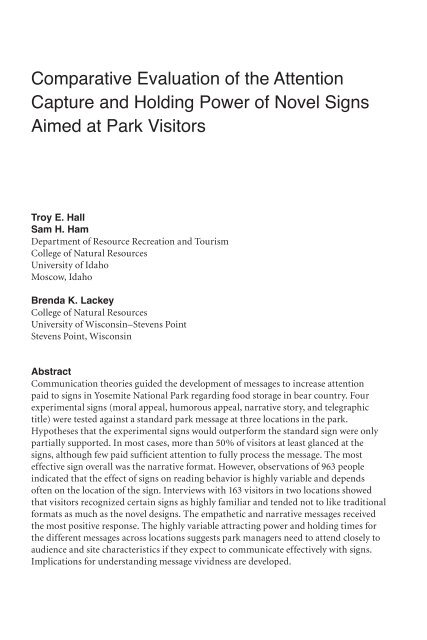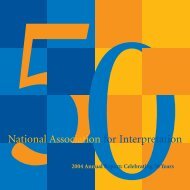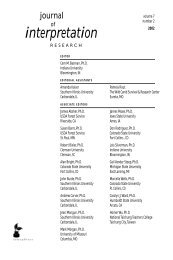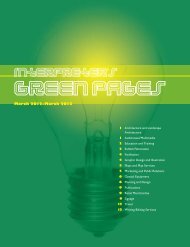interpretation
Volume 15, Number 1 - National Association for Interpretation
Volume 15, Number 1 - National Association for Interpretation
You also want an ePaper? Increase the reach of your titles
YUMPU automatically turns print PDFs into web optimized ePapers that Google loves.
Comparative Evaluation of the Attention<br />
Capture and Holding Power of Novel Signs<br />
Aimed at Park Visitors<br />
Troy E. Hall<br />
Sam H. Ham<br />
Department of Resource Recreation and Tourism<br />
College of Natural Resources<br />
University of Idaho<br />
Moscow, Idaho<br />
Brenda K. Lackey<br />
College of Natural Resources<br />
University of Wisconsin–Stevens Point<br />
Stevens Point, Wisconsin<br />
Abstract<br />
Communication theories guided the development of messages to increase attention<br />
paid to signs in Yosemite National Park regarding food storage in bear country. Four<br />
experimental signs (moral appeal, humorous appeal, narrative story, and telegraphic<br />
title) were tested against a standard park message at three locations in the park.<br />
Hypotheses that the experimental signs would outperform the standard sign were only<br />
partially supported. In most cases, more than 50% of visitors at least glanced at the<br />
signs, although few paid sufficient attention to fully process the message. The most<br />
effective sign overall was the narrative format. However, observations of 963 people<br />
indicated that the effect of signs on reading behavior is highly variable and depends<br />
often on the location of the sign. Interviews with 163 visitors in two locations showed<br />
that visitors recognized certain signs as highly familiar and tended not to like traditional<br />
formats as much as the novel designs. The empathetic and narrative messages received<br />
the most positive response. The highly variable attracting power and holding times for<br />
the different messages across locations suggests park managers need to attend closely to<br />
audience and site characteristics if they expect to communicate effectively with signs.<br />
Implications for understanding message vividness are developed.












